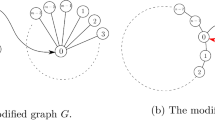Abstract.
The Watts-Strogatz algorithm of transferring the square lattice to a small world network is modified by introducing preferential rewiring constrained by connectivity demand. The evolution of the network is two-step: sequential preferential rewiring of edges controlled by p and updating the information about changes done. The evolving system self-organizes into stationary states. The topological transition in the graph structure is noticed with respect to p. Leafy phase – a graph formed by multiple connected vertices (graph skeleton) with plenty of leaves attached to each skeleton vertex emerges when p is small enough to pretend asynchronous evolution. Tangling phase where edges of a graph circulate frequently among low degree vertices occurs when p is large. There exist conditions at which the resulting stationary network ensemble provides networks which degree distribution exhibit power-law decay in large interval of degrees.
Similar content being viewed by others
References
R. Albert, A.-L. Barabasi, Rev. Mod. Phys. 74, 47 (2002)
S.N. Dorogovtsev, J.F.F. Mendes, Adv. Phys. 51, 1079 (2002)
M.E.J. Newman, SIAM Rev. 45, 167 (2003)
Complex Networks, edited by E. Ben-Naim, H. Frauenfelder, Z. Toroczkai, (Springer, Berlin, 2004)
D.J. Watts, S.H. Strogatz, Nature 393, 440 (1998)
M.E.J. Newman, Pareto laws, Pareto distributions, Zipf's law, e-print arXiv:cond-mat/0412004 (2005)
M. Gitterman, J. Phys. A 33, 8373 (2000); B.J. Kim, H. Hong, P. Holme, G.S. Jeon, P. Minnhagen, M.Y. Choi, Phys. Rev. E 64, 056135 (2001); M.B. Hastings, Phys. Rev. Lett. 91, 098701 (2003)
C.P. Herrero, Phys. Rev. E 65, 0566110 (2002); C.P. Herrero, Phys. Rev. E 69, 067109 (2004)
Jian-Yang Zhu, Han Zhu, Phys. Rev. E 67, 026125 (2003)
A. Aleksiejuk, J.A. Holyst, D. Stauffer, Physica A 310, 260 (2002); M.A. Sumour, M.M. Shabat, D. Stauffer, Absence of ferromagnetism in Ising model on directed Barabasi-Albert network, e-print arXiv:cond-mat/05044660
A.V. Goltsev, S.N. Dorogovtsev, J.F.F. Mendes, Phys. Rev. E 67, 026123 (2003); S.N. Dorogovtsev, A.V. Goltsev, J.F.F. Mendes, Phys. Rev. E 66, 016104 (2002)
S.N. Dorogovtsev, J.F.F. Mendes, A.N. Samukhin, Nucl. Phys. B 666, 396 (2003)
R.F. i Cancho, Ch. Janssen, R.V. Sole, Phys. Rev. E 64, 046119 (2001); M.A. Novotny, S.M. Wheeler, On The possibility of Quasi Small-World Nanomaterials, e-print arXiv:cond-mat/0308602
L.F. Lago-Fernandez, R. Huerta, F. Corbacho, J.A. Siguenza, Phys. Rev. Lett. 84, 2758 (2000)
N. Mathias, V. Gopal, Phys. Rev. E 63, 021117 (2001)
Ch. Cherniak, Trends in Neurosciences 18, 552 (1995)
D. Makowiec, in Cellular Automata, edited by P.M.B. Slot, B. Chopard, A.G. Hoestra (Springer-Verlag, 2004), p. 141
D. Makowiec, New challenges in cellular automata due to network topology, e-print arXiv:cond-mat/0412082
D. Makowiec, Acta Phys. Pol. B 36, 1705 (2005)
M.E. Newman, M. Girvan, Phys. Rev. E 69, 026113 (2004)
M.E. Newman, in Complex Systems, edited by E. Ben-Naim, H. Frauenfelder, Z. Toroczkai (Springer, Berlin, 2004), p. 337
P. Erdös, A. Rényi, Math. Inst. Hung. Acad. Sci. 5, 7 (1960)
I. Farkas, I. Derenyi, G. Palla, T. Viscek, in Complex Networks edited by E. Ben-Naim, H. Frauenfelder, Z. Toroczkai (Springer, Berlin, 2004), p.163
Z. Burda, J.D. Correida, A. Krzywicki, Phys. Rev. E 64, 046118 (2001)
J. Berg, M. Lässing, Phys. Rev. Lett. 89, 228701 (2002)
A.-L. Barabási, R. Albert, Science 286 50, (1999)
Author information
Authors and Affiliations
Corresponding author
Rights and permissions
About this article
Cite this article
Makowiec, D. Evolving network – simulation study. Eur. Phys. J. B 48, 547–555 (2005). https://doi.org/10.1140/epjb/e2006-00008-2
Received:
Published:
Issue Date:
DOI: https://doi.org/10.1140/epjb/e2006-00008-2




